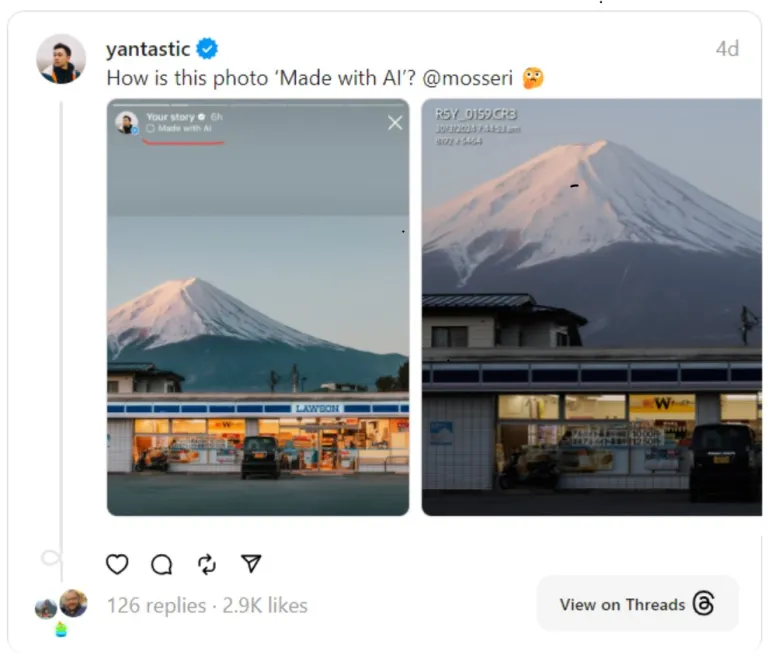Made With AI: How does AI Image Labeling on Instagram and Facebook Work?
In the age of digital artistry and content creation, social media giants like Instagram and Facebook have introduced a new feature: AI Image Labeling. This initiative is designed to identify and label images created or modified using artificial intelligence. But how exactly does this work, and why is it causing a stir among photographers? Let’s dive into the intricacies of this new feature, its implications, and what AI artists need to know.
What is "Made with AI" or "AI Image Labeling" on Instagram and Facebook?
"Made with AI" labels are tags automatically applied to images that are detected to have been generated or significantly altered by artificial intelligence. This feature aims to enhance transparency and help users distinguish between human-created and AI-generated content. By implementing this, Meta hopes to foster a more informed and aware user base, ensuring people know the origins of the content they consume.

How does labeling AI images work on Instagram and Facebook?
The labeling process leverages advanced algorithms capable of analyzing the digital footprint of images. These algorithms look for specific markers indicative of AI involvement, such as certain editing techniques or metadata associated with AI tools. Once an image is flagged, it is labeled with "Made with AI" to alert users to its origins. This process is intended to be seamless, operating in the background without requiring manual intervention from users.
 Now you can also choose to label the image yourself if it is 'Made with AI' (Realistic AI Contents).
Now you can also choose to label the image yourself if it is 'Made with AI' (Realistic AI Contents).
Also read: ChatGPT-4o: The Next Step in AI Evolution - Is It Worth the Hype?
Why Instagram photos are being labeled as ‘Made With AI’ when they’re not?
However, this well-intentioned feature has not been without its issues. Recently, many photographers have reported their images being incorrectly labeled as "Made with AI," even when no AI tools were used in their creation. This mislabeling has sparked frustration among photographers who feel their authenticity and creative efforts are being undermined. The root of this problem appears to be the sensitivity and criteria used by the labeling algorithms, which may need further refinement to accurately distinguish between AI and non-AI content.
 “I did not use generative AI, only Photoshop to clean up some spots. This ‘Made with AI’ label was auto-generated by Instagram when I posted it,” he explained.
“I did not use generative AI, only Photoshop to clean up some spots. This ‘Made with AI’ label was auto-generated by Instagram when I posted it,” he explained.
Yan’s photo was flagged as AI because he used a generative AI tool to remove a trash bin. While removing unwanted objects and spots is a common practice for photographers, having the entire image labeled as AI feels unjust.
Mosseri responded to Yan’s query, asking, “Did this label get added automatically?” As of publication, Yan’s photo of Mount Fuji no longer displays the “Made with AI” marker.
In another case, professional inline skater Julien Cadot had his video labeled as AI. When asked by PetaPixel, Cadot said he had no idea why it was marked as such.
Currently, AI labels appear only on the mobile app, not on the desktop version.
Is this a solution for deep fakes? Will it make any difference?
One of the driving motivations behind AI Image Labeling is combating the rise of deep fakes - realistic but fake images and videos created using AI. By clearly labeling AI-generated content, Meta aims to reduce the spread of misinformation and build trust among users. While this is a step in the right direction, it is not a foolproof solution. Deep fakes are continually evolving, and the effectiveness of labeling will depend on the continual advancement of detection algorithms. Therefore, while it contributes to the fight against deep fakes, it is not a silver bullet.
What should AI Artists know about 'Made with AI' label?
AI artists, who use artificial intelligence as a tool for creative expression, should be aware of how their work will be perceived and labeled on these platforms. Transparency about the use of AI in their creative process can help set expectations for their audience. Additionally, understanding the labeling criteria can assist artists in navigating potential mislabeling issues. Engaging with the community and Meta's feedback channels can also help improve the system, ensuring it better serves both artists and viewers.
Conclusion
The introduction of AI Image Labeling on Instagram and Facebook represents a significant step toward greater transparency in digital content. However, the current challenges highlight the need for ongoing refinement of the technology to balance the benefits of AI detection with the accuracy required by the creative community. As AI continues to shape our digital landscape, staying informed and engaged with these developments will be crucial for all stakeholders involved.









